|
|
|
Those known to have served at RAF Halton during the Second World War 1939-1945. The names on this list have been submitted by relatives, friends, neighbours and others who wish to remember them, if you have any names to add or any recollections or photos of those listed,
please
Add a Name to this List
|
|
|
The Wartime Memories Project is the original WW1 and WW2 commemoration website.
Announcements
- The Wartime Memories Project has been running for 24 years. If you would like to support us, a donation, no matter how small, would be much appreciated, annually we need to raise enough funds to pay for our web hosting and admin or this site will vanish from the web.
- 22nd April 2024 - Please note we currently have a huge backlog of submitted material, our volunteers are working through this as quickly as possible and all names, stories and photos will be added to the site. If you have already submitted a story to the site and your UID reference number is higher than 263973 your information is still in the queue, please do not resubmit, we are working through them as quickly as possible.
- Looking for help with Family History Research?
Please read our Family History FAQ's
- The free to access section of The Wartime Memories Project website is run by volunteers and funded by donations from our visitors. If the information here has been helpful or you have enjoyed reaching the stories please conside making a donation, no matter how small, would be much appreciated, annually we need to raise enough funds to pay for our web hosting or this site will vanish from the web.
If you enjoy this site
please consider making a donation.
Want to find out more about your relative's service? Want to know what life was like during the War? Our
Library contains an ever growing number diary entries, personal letters and other documents, most transcribed into plain text. |
|
We are now on Facebook. Like this page to receive our updates.
If you have a general question please post it on our Facebook page.
Wanted: Digital copies of Group photographs, Scrapbooks, Autograph books, photo albums, newspaper clippings, letters, postcards and ephemera relating to WW2. We would like to obtain digital copies of any documents or photographs relating to WW2 you may have at home. If you have any unwanted
photographs, documents or items from the First or Second World War, please do not destroy them.
The Wartime Memories Project will give them a good home and ensure that they are used for educational purposes. Please get in touch for the postal address, do not sent them to our PO Box as packages are not accepted.
World War 1 One ww1 wwII second 1939 1945 battalion
Did you know? We also have a section on The Great War. and a
Timecapsule to preserve stories from other conflicts for future generations.
|
|
Want to know more about RAF Halton? There are:0 items tagged RAF Halton available in our Library There are:0 items tagged RAF Halton available in our Library 
These include information on officers, regimental histories, letters, diary entries, personal accounts and information about actions during the Second World War. |
|
Sgt. Rowland James George Bazell B Flight 90 Squadron I joined the RAF in August 1942. I had previously applied for Air Crew duties but was turned down because of “unstable colour vision” so entered the service as a flight mechanic under training.
My first 6 weeks consisted of basic training (drill, marching, arms drill, PT etc.) at Blackpool.
At the end of the 6 weeks training I was sent to RAF Halton. About half way through this course an appeal was launched for training as Flight-Engineer. This was a new air-crew category specifically for the four-engined bombers then coming into service.
I applied for this and was successful, so instead of being sent out to a squadron at the end of this flight-mechanic training, I had to stay on at Halton for a Fitter course and then onto St. Athen for a Flight-Engineers course specific to the aircraft I would eventually fly on, namely the Stirling.
Having passed this course I was sent to 90 squadron of 3 Group, Bomber Command, then stationed at Tuddenham, Nr Mildenhall in Suffolk.
My thoughts on the Stirling - being a very robust aircraft and fitted with Hercules air-cooled engines, it was much the safer aircraft in which to fly. It withstood crash landings better and, whereas the Rolls-Royce Merlin engines with which the Lancaster were fitted were magnificent engines, they were liquid cooled and just a bullet or two in the cooling system would rapidly put the engine out of action; whereas I have known air-cooled Hercules engines still give out some power even with a cylinder shot away. However, because of its heavier build, the Sterling did not have the performance of the Lancaster and were eventually replaced by them on “Main Force” targets.
The types of missions which my squadron undertook while I was with them are described below:
The Main Force targets, mentioned above, were the well known bombing missions on German towns and industrial targets, involving many aircraft concentrated over as little time as possible, to saturate defences. This meant contending with masses of search lights, flak, fighters, shot and shell.
Mine Laying - it may not be generally known but at least three quarters of all mines laid within enemy waters were dropped by the RAF. These had to be accurately placed and this called for very accurate navigation. Our navigator, Peter Ashford, was excellent; throughout every flight, even when he knew fairly certainly where we were, he continually checked his calculations. Peter was an expert astro-navigator, in fact after we finished our operational service, he went to the Air Ministry and produced a training manual on the subject, which was used as a basic training manual for years afterwards. He would get me to take endless star-shots and he continuously consulted his GEE box - a very useful early electronic navigation aid. This aid could be unreliable but when it was used mainly over this country and into France, we found it to be very accurate. Due to Peter’s expertise, our crew were given many specialist operations.
Bombing - apart from the first two, our bombing missions were confined mainly to the near coast of France. These targets were small and did not reveal themselves by searchlight / flak etc, hence accurate navigation was needed. These targets were mainly coastal gun emplacements and launching sites for the V-weapons.
Supply Drops - again very small targets often just a map reference in the middle of a wood. To help find them, these trips were always in full moonlight and at low level, generally 500ft, so that the parachutes were in the air for the shortest possible time to avoid detection. We would overfly the target, not circle around, to ensure we did not attract attention. To ascertain we had the right spot, we had to look for a small light (mainly small electric hand torches) flashing a previously agreed letter or letters, which we had to recognise immediately or we were instructed to fly on and bring the load back. We never failed to drop our load.
It was on one of these drops, I think the one dated 29th April, that we took a passenger with us. She was brought out to our aircraft just as we were about to take off. There was absolute secrecy about this, no mention of it in squadron operational records or our log books - she did not in fact exist. Just before reaching her destination, which had been given to our navigator verbally just before take off, he alerted me to go aft, open the rear bottom escape hatch, attach her package to the static line, get her in position to jump (after also attaching her parachute to the static line). At the navigator’s order to “go”, I pushed the package out and she immediately followed. I can just remember her small white face behind her goggles as she dropped into the night. What courage! She was on a on-way trip, we at least had a chance of getting home! The rear gunner reported seeing both parachutes open but as we were very low and had to fly straight on, that was all we saw. Did she survive? Was she captured by the Germans? I would love to know what happened to this very courageous lady.
|
Eileen Bishop RAF Halton My grandmother, Eileen Bishop, was stationed at RAF Halton, Buckinghamshire between 1940 and 1945. She may have worked as a catering officer.
|
A.C.I/LAC Donald George Porritt MU/MEF 107 B Squadron I have found many photos of my father,- Palestine, Egypt, RAF Halton and Cosford.
I think he may have joined up in Jan 1940? - RAF Malton, in A Squadron initially. He was in Egypt by June 1941.
One or two of the photos, have all the names on the back, a group, with names, is dated 28th Aug. Cosford. Block 3. A squadron. 2 Wing. RAF Malton.
I will happily attempt to copy some of the photos if needed.
My father was in the RAF after the war, based in Ismalia, by now married, with mum and me as a baby.
He died in 1950, polio, having left the RAF in approx.1949.
|
Sgt. Dennison Pierce Broomfield 209 Squadron (d.8th Sep 1942) 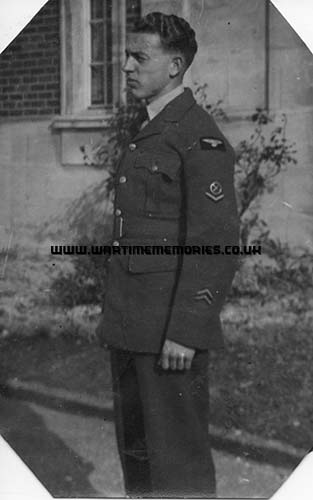 Dennison Pierce Broomfield, was born in 1920 in Bristol.
His mother was Violet Evelyn Broomfield. He trained at RAF Halton as an aircraft apprentice, known as Trenchards Brats. He became Sergeant 570858 of 209 Squadron RAF Volunteer Reserve.
There is a RAF plaque to remember the Halton apprentices, at the National Memorial Arboretum, in Staffordshire.
Dennis died in 1942, in an aircraft accident. He was flying in Catalina VA713.Coded L for Leather. The Operation was an Anti-submarine patrol, which took off from RAF Pamanzi, at 04:20 hrs on Tuesday 8 September 1942 but crashed minutes later, with the loss of all crew.
He is buried at Diego Suarez War Cemetery, near the town of Antsiranana, on the western shore of Diego Suarez Bay, on the north-east coast of Madagascar in Antsiranana War Cemetery.
The Imperial War Museum holds all of his documents including his flying log, photographs of his funeral & personal potographs letters etc.
These were donated by his mother after the war. There is a label at the Imperial War Museum which reads;-
This Atlantic Star (1939-1945) was sent to the next of kin of Sergeant 570858 Dennison Pierce Broomfield, Royal Air Force Volunteer Reserve, who was killed in action on 8 September 1942, aged 22 years, while serving with No 209 Squadron.
|
AC1. John King No 1 School of Technical Training RAF Halton 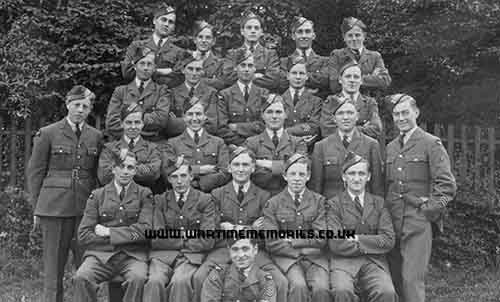 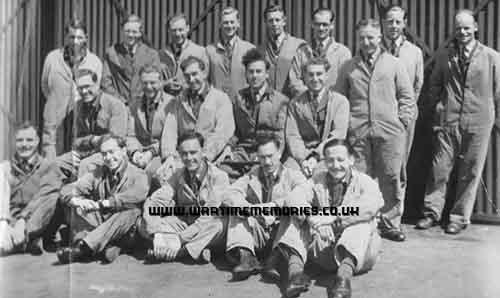 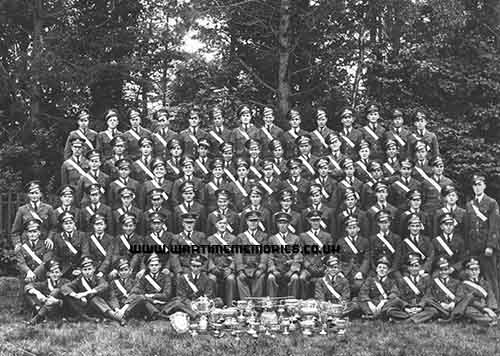 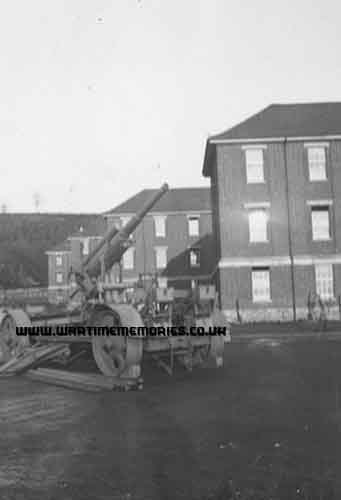 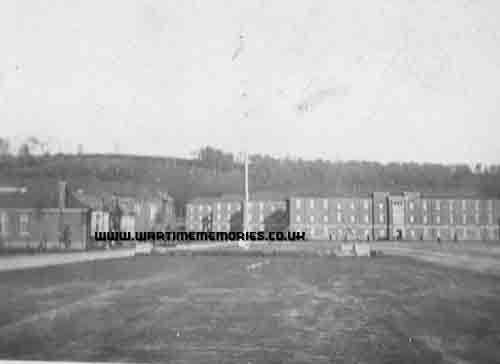 39th Entry RAF Halton
(No 1 School of Technical Training) Apprentice School
17th Jan 1939 575533 Aircraft Apprentice J King
We had a station church, swimming pool, workshops and school buildings. On school days we had various subjects including aerodynamics and technical drawing.
Routine. Early morning a boy went to cookhouse and brought back a bucket of tea and biscuits known as gunfire. Our barrack room had 30 boys in it. Get up and make beds, all blankets and sheets folded to make a neat sandwich. Sometimes rifle drill or PT before breakfast, later march to workshops with our own band with bugles, bagpipes, trumpets and drums. Workshops entailed basic fitting, lectures on metallurgy, heat treatments etc. on to dismantling engines first De Havilland Gypsy engines, then Rolls-Royce Kestrel and Merlin engines and reassembling them, also Bristol Pegasus radial engines, carpentry, blacksmithing, pipework etc.
Engine running was done on the airfield. We had to polish all our floors, clean bathrooms. During our time HRH Duke of Kent (Prince George) came round workshops to inspect our work. I was confirmed in the station church. There was a lot of sport I did swimming, cross-country running and athletics.
We had 2 year course, not 3 as it was wartime. Passing out you had to average 80% on all subjects to pass out LAC (Leading Aircraftsman), 60% average to be AC1 (Aircraftsman 1st class), 40% to be AC2. I passed out AC1. My first flight was in an Avro Tutor 2 seat biplane at Halton airfield. On airfield, we did engine running on a Blenheim, prop swinging on Tiger Moth. We had lunch on airfield from field kitchens, on 3rd Sept 1939 I heard Mr Chamberlain say we were at war with Germany. I was up in the NAAFI listening to the wireless.
|
Sect.Off. Monica Fenton "Nicky" Wingate 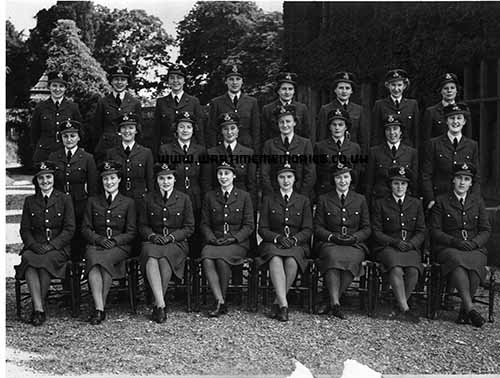 My Grandmother, Monica Wingate, joined the WAAF on 8th September 1939 as an ACW 2 (Aircraftswoman 2) at RAF Halton, Buckinghamshire for initial training and trade training as a plotter.
21st January 1940 posted to Leighton Buzzard, Beds for further training as a plotter.
On the 27th of January 1940 she was posted to RAF Biggin Hill, Kent. Promoted to ACW 1 on 1st May 1940 and Acting Corporal on 1st October 1940.
On the 19th of November she was posted to RAF St Eval, Cornwall.
From the 25th May 1941 to 21st June 1941 she attended Course No.79 at Oxford. This course tested suitability for Code and Cypher work and as she was successful my Grandmother was awarded a Commission. What type of work she was to undertake is not clear at present.
On the 20th June 1941 Commissioned as an Assistant Section Officer (Service No. 2157).
From 23rd June 1941 to 28th June 1941she was at No.1 WAAF's Depot and attended a course at Gerards Cross, London as to how to keep WAAF`s in order. All of my Grandmother`s duties from now on were in Code & Cypher work.
29th June 1941 she joined HQ 14 Group.
On the 22nd July 1941 she was posted to RAF Peterhead in North East Scotland, aFighter Station. Monica was one of the first residents there.
On 5th January 1942 she moved to RAF Tain near Thurso, a Fighter Station, she was Appointed Section Officer on 21st of June 1942.
On 25th October 1942 she moved to RAF Hurn near Bournemouth, Hants.
and on 5th June 1943 was posted to RAF Hurn and transferred to 38 Group Airborne Forces. Activities of 38 Group were towing of gliders and dropping of parachutists.
From 3rd November 1943 to 14th November 1943 she was detached on course to W.O.S Windemere in the Lake District. Then on 25th November 1943 she moved to RAF Ringway near Manchester, 38 Group. No.1 Parachutists School.
On the 21st of February 1945 she moved to RAF Rivenhall near Witham in Essex with 38 Group. Here she met my Grandfather, Squadron Leader William Henry Edwards DFC.
On the 17th May 1945 they were married in St Nicholas Church in Witham, Essex.
On 14th October 1945 she resigned her Commission and left WAAF Service.
It is still unclear what my Grandmother's duties were in Code and Cypher. On the few occasions she spoke about her war service she expressed that they were some of the best times of her life. Many friends were made, lost and extremely difficult times were had. My Grandmother always said that if she had her time all over again and had option to delete her war service, she most definitely would not and is rightly proud of her achievements.
|
LAC. John O'Neill I recently purchased 3 RAF notebooks and other books relating to J O'Neill who served at RAF Halton.
|
LAC. John ONeill John ONeill served at RAF Halton.
|
Recomended Reading.Available at discounted prices.
|
|
|












